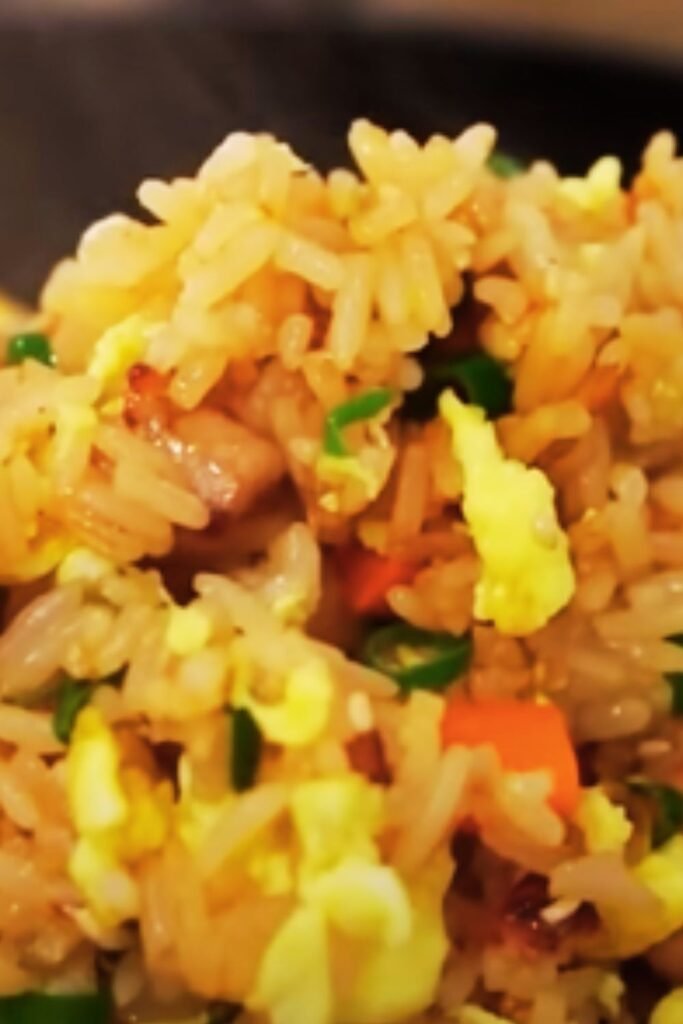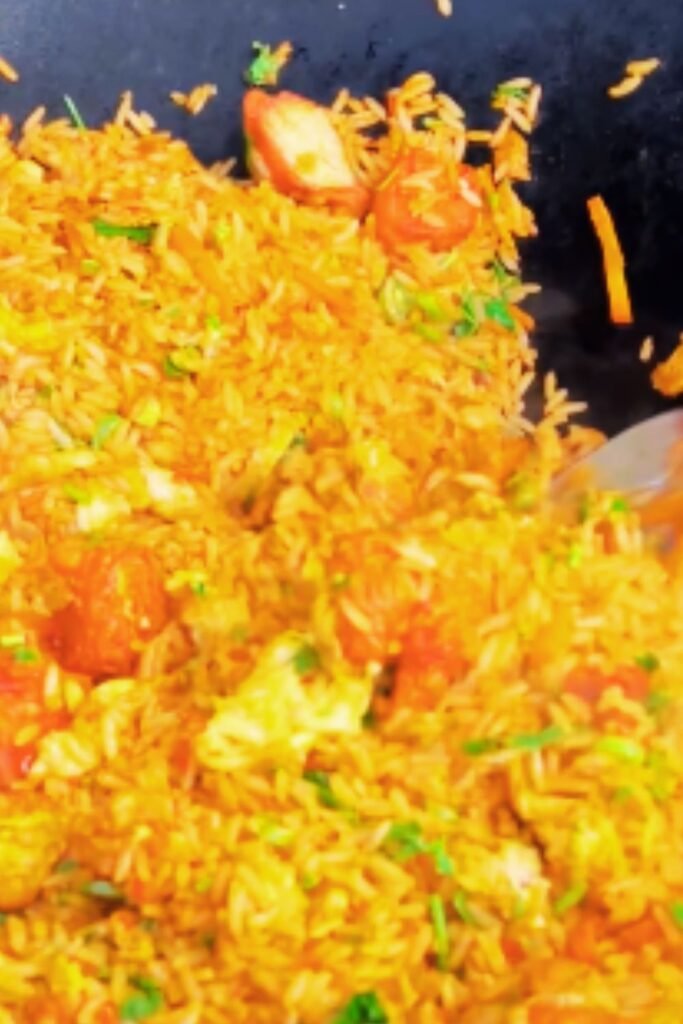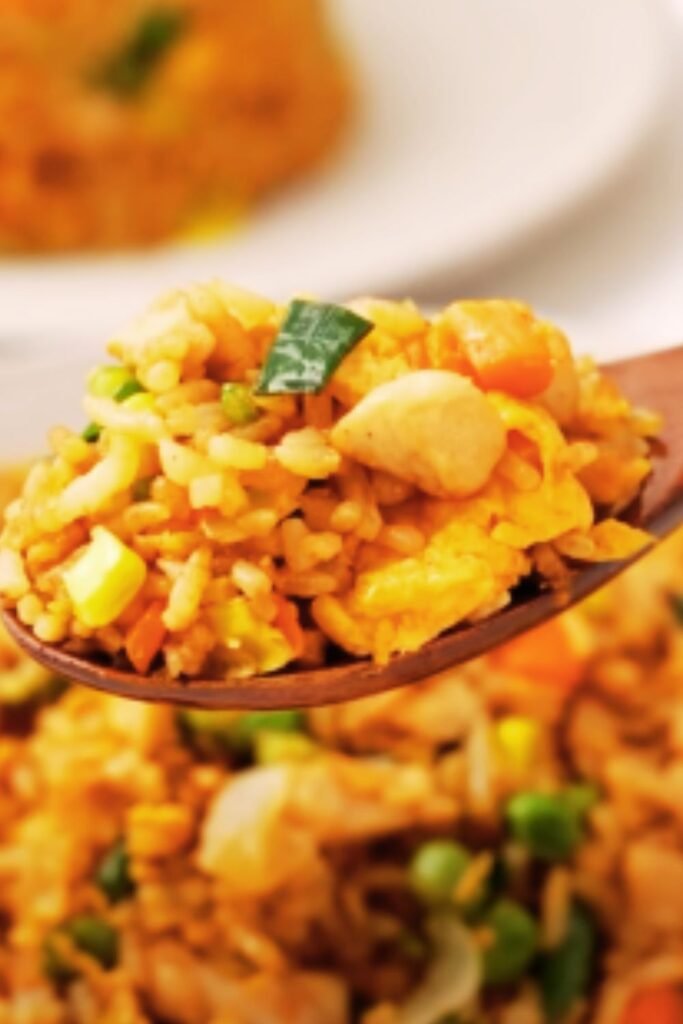There’s something magical about a perfect plate of chicken fried rice. The savory aroma that fills your kitchen, the colorful vegetables peeking through golden grains, and that satisfying combination of textures that makes every bite a delight. I’ve spent years perfecting my recipe, and today I’m sharing all my secrets for making restaurant-quality chicken fried rice right in your own kitchen.
This isn’t just any fried rice recipe. It’s a culmination of techniques I’ve gathered from cooking alongside Asian grandmothers, professional chefs, and through countless hours of kitchen experimentation. Whether you’re looking for a quick weeknight dinner or trying to recreate your favorite takeout dish, this recipe will become your new go-to.
Why This Chicken Fried Rice Recipe Works
Before we dive into the cooking process, let me explain why this particular recipe creates such exceptional results:
- Cold, day-old rice: Using previously cooked and chilled rice prevents clumping and creates that perfect individual grain texture.
- High heat cooking: A properly heated wok or skillet delivers that authentic “wok hei” flavor that restaurant fried rice is known for.
- Layered seasonings: Rather than dumping all ingredients at once, we add them in stages to build complex flavor.
- Protein preparation: Pre-marinating the chicken, even briefly, ensures juicy, flavorful meat throughout.
- Egg technique: Cooking the eggs separately before reincorporating them preserves their texture and distributes them evenly.
These techniques make the difference between mediocre and memorable fried rice. Trust me, your family will be requesting this dish weekly!
Ingredients
For the Chicken Marinade:
- 1 pound boneless, skinless chicken thighs (cut into ½-inch pieces)
- 2 teaspoons soy sauce
- 1 teaspoon Shaoxing wine (or dry sherry)
- ½ teaspoon sesame oil
- ¼ teaspoon white pepper
- 1 teaspoon cornstarch
For the Fried Rice:
- 4 cups cooked long-grain rice (preferably day-old)
- 3 tablespoons neutral oil (like vegetable or peanut), divided
- 3 large eggs, beaten
- 1 medium onion, diced
- 2 carrots, diced small
- ½ cup frozen peas, thawed
- 3 green onions, thinly sliced (whites and greens separated)
- 3 cloves garlic, minced
- 1 tablespoon fresh ginger, grated
For the Sauce:
- 3 tablespoons soy sauce
- 1 tablespoon oyster sauce
- 1 teaspoon toasted sesame oil
- ½ teaspoon white pepper
- ½ teaspoon sugar
Essential Equipment
While you don’t need fancy equipment to make great fried rice, these tools will help:
- A large wok or 12-inch skillet
- A sturdy wooden spoon or wok spatula
- A small bowl for the marinade
- A medium bowl for the sauce mixture
- A plate for setting aside cooked eggs

Step-by-Step Instructions
Preparation (15 minutes)
- Marinate the chicken: In a bowl, combine diced chicken with soy sauce, Shaoxing wine, sesame oil, white pepper, and cornstarch. Mix well and let sit for at least 10 minutes while you prepare other ingredients.
- Prepare the rice: If using freshly cooked rice, spread it on a baking sheet and place in the refrigerator to cool quickly. If using day-old rice, break up any clumps with your fingers.
- Mix the sauce: In a small bowl, combine soy sauce, oyster sauce, sesame oil, white pepper, and sugar. Stir until sugar dissolves and set aside.
- Prep vegetables: Ensure all vegetables are diced, minced, and ready to go before heating your wok.
Cooking Process (15 minutes)
- Cook the eggs: Heat 1 tablespoon of oil in your wok over medium-high heat. Add beaten eggs and scramble until just set but still slightly moist, about 30 seconds. Transfer to a plate and set aside.
- Cook the chicken: Add another tablespoon of oil to the wok and increase heat to high. Add marinated chicken pieces in a single layer and let them sear undisturbed for 30 seconds. Then stir-fry until chicken is cooked through, about 2-3 minutes. Remove and set aside with the eggs.
- Sauté the aromatics: Add the remaining tablespoon of oil to the wok. Add diced onion and the white parts of green onions, stir-frying for 1 minute until fragrant. Add garlic and ginger, cooking for another 30 seconds until aromatic but not browned.
- Add vegetables: Toss in diced carrots and stir-fry for 1-2 minutes until they begin to soften. Add peas and stir to combine.
- Incorporate rice: Add the cold rice to the wok, breaking up any remaining clumps with your spatula. Stir-fry for 2-3 minutes, allowing the rice to heat through and begin to crisp slightly.
- Return proteins and add sauce: Add the cooked chicken and eggs back to the wok. Pour the sauce mixture evenly over everything and toss continuously for 1-2 minutes until well combined and everything is heated through.
- Finish with green onions: Turn off the heat and toss in the green parts of the green onions, reserving a small amount for garnish.
Serving
Transfer to a serving dish and garnish with the remaining green onions. Serve immediately while hot.

Pro Tips for Perfect Chicken Fried Rice
Having made this dish hundreds of times, I’ve learned a few tricks that make a significant difference:
- Don’t overcrowd the wok: If you’re doubling the recipe, cook in batches to maintain high heat.
- Prep everything in advance: Fried rice cooks quickly, so having all ingredients measured and prepped is essential.
- Break up the rice: Use your hands to separate rice grains before adding to the wok to prevent clumping.
- Keep things moving: Continuous stirring prevents burning and ensures even cooking.
- Quality ingredients matter: Fresh ginger, good soy sauce, and proper cooking wine make a noticeable difference.
Rice Options and Preparation
The foundation of great fried rice is, of course, the rice itself. Here’s a detailed comparison of rice options for your fried rice:
| Rice Type | Pros | Cons | Best Uses |
|---|---|---|---|
| Jasmine | Fragrant, fluffy texture | Can become sticky if overcooked | Traditional Southeast Asian style |
| Long-grain white | Separate grains, classic texture | Less aromatic than jasmine | All-purpose fried rice |
| Basmati | Very separate grains, stays fluffy | Different flavor profile than traditional | Fusion styles |
| Brown rice | Higher nutritional value | Requires more cooking liquid | Healthier version |
| Short-grain | Stickier texture | Not traditional for fried rice | Not recommended |
Perfect Rice Preparation
For ideal fried rice texture, follow these steps when cooking your rice:
- Rinse the rice 3-4 times until water runs clear to remove excess starch.
- Use slightly less water than you would for regular rice (about 1:1.25 ratio instead of 1:1.5).
- Let the cooked rice cool completely before refrigerating.
- Refrigerate uncovered for 2-3 hours or overnight for best results.
Common Mistakes to Avoid
Even experienced cooks can fall into these fried rice pitfalls:
- Using warm, freshly cooked rice: This creates sticky, clumpy fried rice.
- Not prepping ingredients in advance: Fried rice moves quickly and waits for no one!
- Low heat cooking: High heat is essential for authentic flavor and texture.
- Overcrowding the pan: This drops the temperature and leads to steaming rather than frying.
- Adding all seasonings at once: Layering flavors creates much more complex taste.
- Skipping the cornstarch in the chicken marinade: This technique, called “velveting,” creates tender, silky meat.
Vegetable Variations
While my recipe includes classic vegetables, fried rice is incredibly versatile. Here are some vegetables that work beautifully:
- Bell peppers: Diced red, yellow, or green
- Bean sprouts: Add at the end for crunch
- Snow peas or sugar snap peas: Sliced diagonally
- Corn kernels: Fresh or frozen
- Mushrooms: Shiitake or button, finely diced
- Broccoli: Cut into very small florets
- Water chestnuts: For added crunch
Protein Alternatives
Not in the mood for chicken? These proteins work wonderfully in this recipe:
- Shrimp: Peel, devein, and marinate as you would the chicken
- Beef: Thinly sliced flank steak works best
- Pork: Ground pork or diced tenderloin
- Tofu: Extra-firm, pressed, and diced
- Edamame: For a vegetarian protein boost
Serving Suggestions
Chicken fried rice makes a complete meal on its own, but these accompaniments elevate the experience:
- Hot sauce or chili oil: For those who enjoy a kick
- Fresh cucumber slices: The cool crunch balances the savory rice
- Steamed or stir-fried bok choy: Adds a nutritious green element
- Crispy wonton strips: For textural contrast
- Sweet and sour cucumber salad: A refreshing side

Storage and Reheating
Made too much? No problem! Chicken fried rice stores and reheats beautifully:
- Refrigeration: Store in an airtight container for up to 3 days.
- Freezing: Place in freezer-safe containers or bags for up to 3 months.
- Reheating: The best way to reheat fried rice is in a skillet with a tablespoon of oil. Microwave works in a pinch (add a sprinkle of water and cover).
Troubleshooting Common Issues
| Problem | Cause | Solution |
|---|---|---|
| Rice is clumping | Too much moisture or rice not chilled | Break up clumps and cook longer to dry out |
| Flavors are bland | Insufficient seasoning | Add a touch more soy sauce or a dash of MSG |
| Rice is mushy | Overcooked rice or too much liquid | Spread rice out and cook longer to dry out |
| Vegetables are too crunchy | Not enough cooking time | Add harder vegetables earlier in the process |
| Chicken is dry | Overcooked or not marinated | Use the velveting technique and watch cooking time |
| Everything is sticking to pan | Not enough oil or heat too low | Ensure proper oil amount and maintain high heat |
Nutritional Information
For those watching their macros, here’s an approximate nutritional breakdown per serving (recipe makes 4 servings):
| Nutrient | Amount |
|---|---|
| Calories | 425 kcal |
| Protein | 24g |
| Carbohydrates | 48g |
| Fat | 15g |
| Fiber | 3g |
| Sodium | 820mg |
| Sugar | 3g |
Frequently Asked Questions
Q: Can I use freshly cooked rice instead of day-old rice?
Yes, but you’ll need to adjust your technique. Cook the rice with slightly less water than usual, then spread it on a baking sheet to cool completely before using. For best results, place it in the freezer for 15-20 minutes to cool rapidly.
Q: How can I make this recipe gluten-free?
Simply substitute regular soy sauce with tamari or certified gluten-free soy sauce, and ensure your oyster sauce is gluten-free (or use a gluten-free substitute like mushroom sauce).
Q: What’s the secret to restaurant-quality fried rice?
Three key factors: high heat, cold rice, and cooking ingredients in stages rather than all at once. Also, many restaurants add a touch of MSG, which you can optionally include (¼ teaspoon) for enhanced flavor.
Q: Can I make this dish vegetarian?
Absolutely! Replace the chicken with extra-firm tofu (pressed and diced) or a plant-based chicken alternative. Substitute the oyster sauce with vegetarian mushroom sauce.
Q: Why is my fried rice never as good as takeout?
Most home stoves don’t reach the extremely high temperatures of commercial wok burners. To compensate, use a cast-iron skillet or carbon steel wok preheated for several minutes, and cook in smaller batches to maintain heat.
Q: How spicy is this recipe?
As written, it’s very mild and family-friendly. If you enjoy heat, add 1-2 teaspoons of chili oil or a tablespoon of sambal oelek when adding the sauce.
Q: Can I prep any components ahead of time?
Yes! The chicken can be marinated up to 24 hours ahead, vegetables can be chopped and stored in the refrigerator, and the sauce can be mixed and refrigerated. All these steps make the final cooking process much quicker.
Q: What’s the best rice-to-meat ratio?
For a balanced meal, I recommend the ratio in this recipe (1 pound of chicken to 4 cups of cooked rice). However, you can adjust according to your preference, adding more chicken for a protein-heavy meal or more vegetables for a lighter option.
The History Behind Chicken Fried Rice
Fried rice has a fascinating history dating back to the Sui Dynasty in China (589–618 CE). Originally created as a way to use leftover rice and prevent waste, it has evolved into countless regional variations across Asia and beyond.
The addition of chicken to fried rice became popular during the 20th century as protein became more accessible to everyday people. Today, chicken fried rice is enjoyed worldwide, with each culture adding its own twist to this versatile dish.
Whether you’re making this dish to use up leftovers (as traditionally intended) or preparing it as a planned meal, you’re participating in a culinary tradition that spans centuries and continents.
Final Thoughts
Chicken fried rice is more than just a quick dinner solution—it’s a canvas for creativity and a satisfying meal that brings people together. With these techniques and tips, you’ll be making restaurant-quality fried rice that will have friends and family thinking you’ve been hiding professional culinary training!
Remember, the beauty of fried rice is its flexibility. Don’t be afraid to experiment with different proteins, vegetables, and seasonings once you’ve mastered the basic technique. Your perfect version of chicken fried rice might be just one ingredient swap away from discovery.
Happy cooking, and may your rice always be perfectly crispy and your chicken tender and flavorful!


